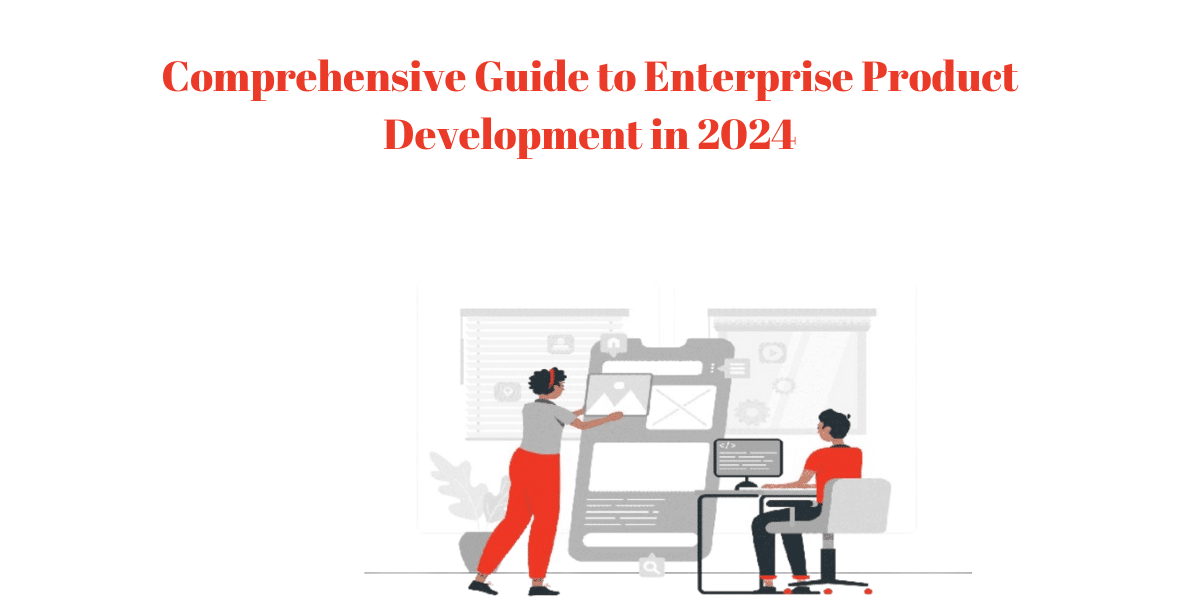Welcome to the Comprehensive Guide to Enterprise Product Development in 2024, a roadmap navigating the dynamic landscape of creating, optimizing, and launching products in the enterprise sector. In today’s fast-paced and technology-driven world, staying ahead requires a deep understanding of emerging trends, innovative methodologies, and strategic insights into the global marketplace. This guide aims to provide a holistic view of the intricacies involved in enterprise product development, offering a valuable resource for professionals, leaders, and enthusiasts alike.
As we step into 2024, the enterprise product development realm continues to evolve with advancements in artificial intelligence, data analytics, and agile methodologies. This comprehensive guide explores key components of successful enterprise product development strategies, delving into the integration of cutting-edge technologies, sustainable practices, and user-centric design principles.
Whether you’re a seasoned professional seeking to refine your approach or a newcomer looking to grasp the fundamentals, this guide is designed to equip you with the knowledge and tools necessary to navigate the challenges and opportunities inherent in the ever-evolving landscape of enterprise product development.
Current Trends in Enterprise Product Development
In the dynamic realm of enterprise product development, several current trends are reshaping the way organizations conceive, design, and deliver their products. One prominent trend revolves around the increasing integration of artificial intelligence (AI) and machine learning (ML) technologies. These advanced capabilities empower enterprises to automate processes, enhance decision-making, and even create more intelligent and adaptive products. Another significant trend is the pervasive influence of data analytics throughout the product development lifecycle. Enterprises are leveraging big data to glean valuable insights into customer behavior, market trends, and product performance, enabling data-driven decision-making and informed iterations.
Agile methodologies continue to dominate, fostering flexibility and collaboration within development teams. The emphasis on cross-functional collaboration has led to the rise of multidisciplinary teams, where experts from diverse fields work cohesively to bring products to market efficiently. Furthermore, the incorporation of user-centric design principles is gaining prominence, ensuring that products are not only technologically advanced but also resonate with end-users. Cloud-based solutions are ubiquitous, providing scalability, flexibility, and accessibility for distributed teams.
Sustainability is a key theme, with enterprises increasingly adopting eco-friendly practices in product development. This includes incorporating recycled materials, reducing carbon footprints, and designing products with a focus on environmental impact. Lastly, the rapid adoption of DevOps practices is streamlining development pipelines, accelerating time-to-market, and enhancing collaboration between development and operations teams. As enterprises navigate this landscape, staying abreast of these trends becomes crucial for crafting innovative, competitive, and market-responsive products in 2024 and beyond.
Importance of Product Development in the Enterprise Sector
Product development stands as a cornerstone of success in the enterprise sector, playing a pivotal role in fostering innovation, competitiveness, and sustainable growth. At its core, effective product development is a strategic imperative for enterprises aiming to meet ever-evolving consumer demands and navigate dynamic market landscapes. By consistently introducing new and improved products, enterprises can stay ahead of the competition, differentiate their offerings, and capture new market segments. Furthermore, robust product development processes enable enterprises to adapt to emerging technologies, ensuring relevance in an increasingly digitalized world.
In the enterprise sector, the importance of product development extends beyond immediate revenue generation; it serves as a catalyst for long-term business viability. Successful product development strategies involve understanding customer needs, market trends, and technological advancements, allowing enterprises to align their offerings with the evolving preferences of their target audience. This customer-centric approach not only enhances customer satisfaction but also builds brand loyalty, fostering enduring relationships that contribute to sustained business success.
Moreover, effective product development is intricately linked to the overall innovation culture within an enterprise. It encourages a proactive mindset, pushing organizations to explore novel ideas, invest in research and development, and experiment with emerging technologies. This innovation-driven approach positions enterprises as industry leaders, capable of introducing groundbreaking solutions and disrupting traditional markets.
In summary, enterprise product development in the enterprise sector is not merely a functional process but a strategic imperative. It empowers enterprises to adapt, innovate, and thrive in an ever-changing business landscape, ultimately shaping their trajectory towards sustained success and market leadership.
Key Components of a Successful Product Development Strategy
A successful product development strategy in the modern business landscape comprises a carefully orchestrated blend of key components, each playing a crucial role in the journey from conception to market launch. Market research stands as a foundational element, providing insights into consumer needs, preferences, and emerging trends. By understanding the target audience, businesses can tailor their products to meet specific demands, ensuring relevance and resonance in the market. A robust ideation process follows, encouraging innovation and the exploration of novel ideas that can differentiate a product from competitors. Concurrently, effective project management becomes essential, ensuring that timelines are met, resources are allocated efficiently, and the development process remains on track.
The integration of agile methodologies is another critical component, allowing teams to respond swiftly to changes, incorporate feedback iteratively, and maintain a flexible approach throughout the development lifecycle. Cross-functional collaboration emerges as a key factor, bringing together diverse expertise from various departments, such as design, engineering, marketing, and sales. This collaborative approach ensures that the final product aligns with both technical requirements and market expectations. Prototyping and iterative development also feature prominently, enabling teams to test and refine concepts, identify potential issues early on, and enhance the overall quality of the final product.
Moreover, a successful product development strategy necessitates a keen focus on scalability and adaptability. Products should be designed with future growth and technological advancements in mind, allowing for seamless updates and expansions. Finally, a comprehensive go-to-market plan, encompassing marketing, distribution, and customer support strategies, is indispensable for successfully introducing the product to the target audience. In essence, a well-rounded product development strategy weaves these components together, ensuring a holistic and effective approach to bringing innovative and competitive products to market.
Integrating Emerging Technologies in Enterprise Product Development
Integrating emerging technologies into enterprise product development is a strategic imperative that empowers businesses to stay at the forefront of innovation and gain a competitive edge in the dynamic market landscape. One pivotal aspect of this integration is leveraging artificial intelligence (AI) and machine learning (ML) technologies to enhance product functionality, automate processes, and derive actionable insights from data. These technologies not only streamline development processes but also enable the creation of intelligent, adaptive products that can cater to evolving user needs. Furthermore, the incorporation of the Internet of Things (IoT) facilitates the development of interconnected products, enabling real-time data exchange and enhancing the overall user experience.
Blockchain technology is another emerging trend making waves in enterprise product development, offering enhanced security, transparency, and traceability. By implementing blockchain, enterprises can build trust in their products, particularly in industries where secure and tamper-proof records are paramount. Augmented Reality (AR) and Virtual Reality (VR) are transforming the way users interact with products, providing immersive experiences and novel functionalities. Integrating these technologies into product development can lead to innovative solutions across various sectors, from training simulations to enhanced product visualization.
Moreover, edge computing is gaining prominence, allowing enterprises to process data closer to the source, reducing latency and improving the performance of products that rely on real-time data analysis. As enterprises navigate the fourth industrial revolution, the integration of 5G technology becomes essential for enabling faster communication, enhancing connectivity, and unlocking new possibilities for product features and capabilities. In essence, the strategic integration of these emerging technologies into enterprise product development not only catalyzes innovation but also positions businesses to meet the evolving demands of a tech-savvy market.
Agile Methodology in Enterprise Product Development
The Agile methodology has emerged as a transformative force in enterprise product development, reshaping traditional approaches and fostering a more adaptive, collaborative, and customer-centric environment. At its core, Agile emphasizes iterative and incremental development, enabling teams to respond swiftly to changing requirements and market dynamics. This iterative approach allows for continuous improvement and flexibility throughout the product development lifecycle. Cross-functional teams lie at the heart of Agile, bringing together individuals with diverse skill sets to collaborate closely and share collective ownership of the project. Regular communication and feedback loops, facilitated by methods such as Scrum or Kanban, promote transparency, minimize misunderstandings, and ensure alignment with customer expectations.
One of the key strengths of Agile in enterprise product development is its customer-centric focus. By prioritizing customer feedback and incorporating it into iterative development cycles, Agile methodologies ensure that the final product aligns closely with user needs and preferences. Additionally, Agile methodologies contribute to risk mitigation by identifying and addressing potential challenges early in the development process. The emphasis on adaptability allows enterprises to navigate uncertainties and respond proactively to emerging opportunities or market shifts. Agile’s impact extends beyond software development, with its principles being increasingly adopted in diverse industries such as manufacturing, marketing, and finance.
Ultimately, Agile methodology fosters a culture of collaboration, continuous improvement, and customer satisfaction, making it a powerful framework for enterprises seeking to enhance their product development processes in the fast-paced and dynamic landscape of 2024.
The Role of Data Analytics in Shaping Product Development
The role of data analytics in shaping product development is integral to creating innovative, market-responsive, and customer-centric solutions in the contemporary business landscape. Data analytics empowers enterprises to harness the vast amounts of information at their disposal, providing valuable insights into customer behavior, market trends, and product performance. By leveraging analytics tools, organizations can make informed decisions throughout the product development lifecycle. Customer preferences, feedback, and usage patterns are analyzed to identify opportunities for improvement and innovation. Predictive analytics enables businesses to anticipate future trends and demands, aiding in strategic planning and resource allocation.
Moreover, data-driven decision-making is paramount in optimizing features and functionalities, ensuring that the final product aligns closely with the evolving needs of the target audience. A deep understanding of user interactions and preferences, derived from analytics, facilitates the creation of personalized and user-friendly experiences. Additionally, data analytics plays a crucial role in risk management, helping identify potential issues early in the development process and enabling proactive mitigation strategies.
In the era of big data, advanced analytics techniques such as machine learning further enhance product development by uncovering complex patterns and correlations. These insights not only guide feature prioritization but also contribute to the development of intelligent, adaptive products. Furthermore, analytics-driven performance metrics aid in measuring the success of a product post-launch, allowing for continuous refinement based on real-time feedback and usage data. In essence, the strategic integration of data analytics in product development empowers enterprises to make data-driven decisions, enhance customer satisfaction, and stay ahead in a competitive and rapidly evolving market.
Design Thinking Approaches for Enterprise Products
Design thinking has emerged as a transformative approach in developing enterprise products, placing a profound emphasis on empathy, collaboration, and iterative problem-solving. At its core, design thinking starts with a deep understanding of end-users, their needs, and their pain points. This empathetic understanding forms the foundation for ideation, where multidisciplinary teams collaborate to generate innovative solutions. By fostering an environment where diverse perspectives are valued, design thinking ensures that the resulting product addresses a wide range of user requirements. The iterative nature of design thinking encourages continuous prototyping and testing, allowing teams to refine and enhance the product based on user feedback.
In the context of enterprise products, design thinking becomes a powerful catalyst for human-centric innovation. It involves not only the visual and functional aspects of product design but also the overall user experience and the emotional connection users have with the product. This approach promotes the creation of products that not only meet functional requirements but also resonate with users on a deeper level. Design thinking’s focus on collaboration encourages cross-functional teams to work together, fostering a culture of collective problem-solving and creativity.
Furthermore, design thinking extends beyond the product development phase, influencing how enterprises approach challenges and opportunities. It becomes a mindset that permeates organizational culture, encouraging a continuous cycle of observation, ideation, and implementation. In the rapidly evolving landscape of enterprise products, design thinking stands as a guiding philosophy that ensures innovation is rooted in a deep understanding of users, leading to the creation of products that not only meet but exceed user expectations.
Collaborative Tools for Remote Enterprise Product Teams
The advent of remote work has necessitated the integration of collaborative tools for enterprise product teams, revolutionizing the dynamics of teamwork and project management. In a distributed work environment, effective communication and seamless collaboration are paramount, and collaborative tools play a pivotal role in bridging the physical gaps between team members. Project management platforms like Asana, Trello, or Jira enable teams to coordinate tasks, set priorities, and track progress in real-time. Communication tools such as Slack, Microsoft Teams, or Zoom facilitate instant messaging, video conferencing, and virtual meetings, fostering a sense of connection among team members despite geographical distances.
Document collaboration tools like Google Workspace or Microsoft Office 365 empower remote teams to collectively work on documents, spreadsheets, and presentations in real-time. Version control features ensure that everyone is working on the latest updates, eliminating confusion and enhancing productivity. Additionally, cloud-based storage solutions like Dropbox or OneDrive provide a centralized repository for files, promoting accessibility and seamless sharing.
For design and development teams, collaborative platforms such as Figma or InVision streamline the creation and review of design assets, allowing team members to collaborate synchronously on user interfaces and prototypes. Version history and commenting features enhance feedback loops, ensuring a smooth and iterative design process. The integration of these collaborative tools not only facilitates efficient project management but also nurtures a collaborative culture where ideas flow freely, and teams can collectively contribute to the success of enterprise product development, irrespective of their physical locations. As remote work becomes increasingly prevalent, the adoption of these tools becomes crucial for maintaining cohesion and productivity within enterprise product teams.
Navigating Regulatory Challenges in Product Development
Navigating regulatory challenges in product development is a complex and critical aspect for enterprises, requiring a strategic and proactive approach to ensure compliance while fostering innovation. Regulatory landscapes vary across industries and regions, necessitating a comprehensive understanding of applicable laws, standards, and certification requirements. It is imperative for product development teams to engage in continuous monitoring of regulatory updates and changes, staying abreast of evolving compliance requirements. Establishing clear communication channels with regulatory bodies helps in gaining insights into expectations and navigating potential hurdles early in the development process.
Moreover, collaboration between legal, regulatory affairs, and product development teams is essential for integrating compliance measures seamlessly into the product development lifecycle. Early engagement with regulatory experts can aid in identifying potential challenges and developing strategies to address them effectively. Documentation and traceability throughout the development process are critical to demonstrate compliance, and utilizing tools such as regulatory information management systems can enhance efficiency in this regard.
Innovation must be balanced with a thorough risk assessment that considers not only product functionality and safety but also regulatory implications. Collaborating with third-party testing and certification bodies can provide an external perspective, ensuring that products meet industry and regulatory standards. Proactive engagement with stakeholders, including regulatory agencies, industry forums, and legal experts, fosters a transparent and collaborative approach to regulatory compliance. Ultimately, successfully navigating regulatory challenges requires a holistic strategy that integrates compliance considerations into every stage of product development, ensuring that innovative solutions meet the necessary regulatory approvals and can be confidently brought to market.
Sustainable and Eco-Friendly Practices in Enterprise Products
Embracing sustainable and eco-friendly practices in enterprise products has become an imperative as businesses increasingly recognize their responsibility to address environmental concerns. Sustainable product development involves adopting practices that minimize the ecological footprint across the entire product lifecycle. This begins with the selection of environmentally friendly materials and manufacturing processes that reduce resource consumption and waste generation. From design to disposal, enterprises are incorporating life cycle assessments to quantify and mitigate environmental impacts. Sustainable packaging, utilizing recyclable or biodegradable materials, is gaining prominence to minimize the environmental impact of product distribution and disposal.
Moreover, enterprises are incorporating circular economy principles, focusing on the reuse, refurbishment, and recycling of products to extend their lifespan and reduce overall resource consumption. Energy-efficient manufacturing processes and the use of renewable energy sources further contribute to the eco-friendliness of enterprise products. Sustainable sourcing practices, such as responsibly procuring raw materials and ensuring fair labor practices, align with ethical considerations and contribute to a positive environmental and social impact.
Consumer awareness and demand for eco-friendly products are driving enterprises to adopt sustainability as a core value. Certifications like Cradle to Cradle or Energy Star are becoming benchmarks for consumers seeking products with reduced environmental impact. Embracing sustainability not only aligns businesses with global environmental goals but also enhances brand reputation, attracting environmentally conscious consumers. As enterprises continue to integrate sustainable practices into product development, they play a vital role in fostering a greener and more responsible future.
User-Centric Design Principles for Enterprise Solutions
User-centric design principles are paramount in shaping effective and successful enterprise solutions, emphasizing a deep understanding of end-users and their needs throughout the design and development process. At the core of user-centric design is empathy, requiring enterprises to actively engage with and comprehend the perspectives, goals, and challenges of their target users. This approach ensures that enterprise solutions are not only functional but also intuitive, addressing the specific requirements and preferences of the end-users. The iterative nature of user-centric design involves continuous feedback loops, usability testing, and prototyping, allowing enterprises to refine and optimize solutions based on real-world user interactions.
Enterprise solutions designed with a user-centric approach prioritize user experience (UX), creating interfaces that are intuitive, accessible, and enjoyable to interact with. Accessibility considerations are integral, ensuring that the solution caters to users with diverse needs and abilities. Design thinking methodologies often underpin user-centric design, encouraging cross-functional collaboration to incorporate diverse perspectives and skill sets in the development process. Additionally, the deployment of user personas, user journey mapping, and usability studies helps enterprises gain valuable insights into user behaviors and preferences, guiding informed design decisions.
Ultimately, by placing the end-user at the center of the design process, enterprises enhance user satisfaction, increase productivity, and drive user adoption of their solutions. User-centric design principles not only contribute to the success of enterprise solutions but also foster a culture of continuous improvement, responsiveness, and innovation within organizations, aligning technology with the evolving needs and expectations of users in diverse enterprise contexts.
Cross-Functional Teams in Enterprise Product Development
Cross-functional teams in enterprise product development represent a transformative approach that brings together individuals with diverse expertise and skill sets, fostering collaboration and innovation throughout the product lifecycle. Unlike traditional hierarchical structures, cross-functional teams consist of members from various departments such as design, development, marketing, and quality assurance, each contributing their unique perspectives and capabilities. This interdisciplinary collaboration ensures that different aspects of product development, from ideation to implementation, are considered simultaneously, leading to comprehensive and well-rounded solutions. Communication channels are streamlined within cross-functional teams, allowing for real-time exchange of ideas, feedback, and insights, thereby accelerating decision-making processes and minimizing delays.
The integration of cross-functional teams is particularly crucial in the rapidly changing landscape of enterprise product development, where adaptability and responsiveness are key. The diversity of skills and backgrounds within these teams facilitates a holistic approach to problem-solving, addressing challenges from multiple angles. Moreover, cross-functional collaboration promotes a shared sense of ownership and accountability for the project’s success, fostering a collaborative culture within the organization. This approach not only accelerates time-to-market but also enhances the overall quality of the final product by considering various perspectives and potential challenges.
In essence, cross-functional teams empower enterprises to navigate the complexities of modern product development, aligning diverse skills and knowledge to create products that not only meet technical requirements but also resonate with end-users and the broader market. As a result, this collaborative model stands as a cornerstone in fostering agility, innovation, and efficiency in enterprise product development initiatives.
Leveraging Artificial Intelligence in Product Development Processes
Leveraging artificial intelligence (AI) in product development processes marks a transformative shift, introducing unprecedented efficiencies, insights, and capabilities across the entire product lifecycle. AI’s ability to process vast amounts of data quickly enables data-driven decision-making from the outset, aiding in market research, trend analysis, and identification of consumer needs. Machine learning algorithms contribute to predictive modeling, offering valuable insights into potential product performance and user behavior. During the development phase, AI-driven tools assist in iterative design optimization, automating tasks such as prototyping, testing, and quality assurance.
Natural language processing (NLP) and sentiment analysis empower teams to analyze customer feedback, social media, and market trends, facilitating a nuanced understanding of user preferences. Chatbots and virtual assistants streamline customer interactions, providing real-time support and feedback, thereby enhancing user experience. AI-driven analytics continue to play a pivotal role post-launch, monitoring product performance, identifying areas for improvement, and enabling continuous innovation.
Moreover, AI enables the creation of intelligent and adaptive products, incorporating features such as personalized recommendations, autonomous decision-making, and real-time customization. This not only enhances user satisfaction but positions products as cutting-edge and responsive to dynamic market demands. Integrating AI into product development processes also contributes to operational efficiency, automating routine tasks, reducing time-to-market, and allowing human resources to focus on creative and strategic aspects of development. In the rapidly evolving landscape of 2024, enterprises leveraging AI in product development are poised not only to stay competitive but also to pioneer innovative solutions that shape the future of technology and user experience.
Prototyping and Iterative Development Strategies
Prototyping and iterative development strategies are pivotal components of a dynamic and responsive product development process, fostering innovation, reducing risks, and ensuring that the final product meets user expectations. Prototyping involves creating preliminary versions of a product to visualize and test its design, functionality, and user interface. This iterative approach allows development teams to gather valuable feedback early in the process, identify potential issues, and make informed refinements. The iterative cycle, wherein each iteration builds upon the previous one, ensures a continuous feedback loop, refining and enhancing the product incrementally.
Prototypes serve as tangible representations of ideas, enabling stakeholders to better understand the proposed solution and providing a foundation for collaborative decision-making. This visual and tangible representation aids in communicating complex concepts and design choices, aligning stakeholders on the product vision. Additionally, prototyping is instrumental in user testing, allowing designers and developers to assess usability, identify pain points, and gauge user satisfaction.
Iterative development strategies, often aligned with agile methodologies, emphasize continuous cycles of planning, designing, building, testing, and refining. This approach not only accelerates time-to-market but also allows for flexibility and adaptability to changing requirements. The iterative nature of development ensures that products evolve in response to user feedback, market dynamics, and emerging trends, resulting in solutions that are not only functional but also resonate with end-users. In the rapidly evolving landscape of enterprise product development, the integration of prototyping and iterative strategies stands as a cornerstone for creating products that are not only innovative but also highly responsive to user needs and market demands.
Cloud-Based Solutions for Enterprise Product Development
Cloud-based solutions have become integral to modern enterprise product development, revolutionizing the way teams collaborate, innovate, and bring products to market. The cloud provides a scalable and flexible infrastructure that enables distributed teams to seamlessly collaborate in real-time, breaking down geographical barriers and fostering a collaborative environment. Development teams can leverage cloud-based tools for version control, code repositories, and continuous integration/continuous deployment (CI/CD), streamlining the development process and ensuring efficient collaboration among developers, testers, and other stakeholders. Cloud platforms offer on-demand resources, enabling enterprises to scale their computing power and storage needs dynamically, aligning with the varying requirements of product development phases.
Moreover, cloud-based solutions facilitate the integration of emerging technologies such as artificial intelligence and machine learning into product development processes. These technologies can leverage cloud resources for data storage, processing, and analysis, enabling more sophisticated and resource-intensive applications. The cloud’s accessibility and ease of integration with third-party services also empower enterprises to incorporate external tools and APIs seamlessly into their product development workflows. Additionally, cloud-based solutions enhance data security and disaster recovery, ensuring that critical project information is backed up and accessible from anywhere.
In the landscape of 2024, where agility, collaboration, and innovation are paramount, cloud-based solutions serve as a catalyst for accelerating product development cycles, reducing time-to-market, and positioning enterprises to harness the full potential of emerging technologies in a scalable and cost-effective manner.
Security Considerations in Enterprise Product Design
Security considerations in enterprise product design are paramount in an era marked by increasing cyber threats and a growing emphasis on protecting sensitive information. Ensuring the security of products involves a multifaceted approach, starting with a thorough risk assessment during the initial phases of product design. Identifying potential vulnerabilities, both in terms of software and hardware, is crucial for pre-emptively addressing security concerns. Implementing secure coding practices is essential to mitigate risks such as code injection, cross-site scripting, and other common exploits. Encryption mechanisms must be incorporated to safeguard data both in transit and at rest, ensuring that sensitive information remains confidential.
Access control mechanisms, including robust authentication and authorization protocols, help prevent unauthorized access and limit privileges based on user roles. Regular security audits and penetration testing are integral components of the design process, allowing enterprises to identify and rectify vulnerabilities before products reach the market. Moreover, enterprises must stay vigilant about emerging threats and adhere to industry best practices and compliance standards to maintain a secure product ecosystem.
As products increasingly rely on interconnected technologies, the security of application programming interfaces (APIs) and data exchange protocols becomes paramount. Embedding security into the product development lifecycle, from design to deployment, establishes a proactive security posture, reducing the likelihood of breaches and minimizing potential damages. In the landscape of 2024, where data breaches and cyber-attacks are pervasive, prioritizing security considerations in enterprise product design is not only a best practice but a fundamental responsibility to protect both organizations and their users from evolving threats.
Importance of Market Research in Enterprise Product Planning
Market research stands as a cornerstone in the strategic planning of enterprise products, playing a pivotal role in shaping successful product development and launch strategies. At its essence, market research involves a systematic investigation into market dynamics, consumer behaviors, and industry trends, providing invaluable insights that guide decision-making throughout the product planning lifecycle. By thoroughly understanding the target market, enterprises can identify unmet needs, assess competitors, and gauge the demand for innovative solutions. This informed approach not only minimizes the risks associated with product launches but also maximizes the chances of creating products that resonate with the intended audience.
Market research facilitates the identification of key demographic and psychographic factors, enabling enterprises to tailor products to specific customer segments effectively. Understanding consumer preferences, pain points, and expectations allows for the development of features that align closely with user needs, fostering customer satisfaction and loyalty. Moreover, market research aids in pricing strategies, helping enterprises determine optimal pricing points that balance competitiveness with profitability.
In the dynamic landscape of 2024, characterized by rapidly evolving technologies and changing consumer expectations, market research is crucial for staying agile and responsive. It provides the foundation for informed decision-making, allowing enterprises to adapt their product offerings to emerging trends and shifts in market demand. Ultimately, the importance of market research in enterprise product planning extends beyond risk mitigation; it becomes a strategic imperative for crafting products that not only meet but exceed the expectations of the target market, positioning enterprises for sustained success in a competitive business environment.
Effective Project Management in Enterprise Product Development
Effective project management is indispensable in the complex landscape of enterprise product development, serving as the linchpin that ensures successful execution, timely delivery, and optimal resource utilization. In the realm of product development, projects are intricate endeavors with multifaceted requirements, involving cross-functional teams, varied stakeholders, and intricate workflows. Project managers play a pivotal role in orchestrating these elements, from defining project scopes and milestones to managing budgets, timelines, and team dynamics. Utilizing established project management methodologies such as Agile or Scrum fosters adaptability, enabling teams to respond swiftly to changes, incorporate feedback, and iteratively refine the product.
Clear communication is a cornerstone of effective project management, encompassing regular updates, transparent reporting, and efficient collaboration. Project managers facilitate cross-functional collaboration, ensuring that designers, developers, marketers, and other stakeholders work cohesively towards common objectives. Additionally, risk management is integral, involving the identification, assessment, and mitigation of potential challenges throughout the project lifecycle. Proactive issue resolution and the ability to recalibrate strategies in response to unforeseen circumstances are crucial aspects of effective project management.
In the landscape of 2024, where the pace of technological change is rapid and market dynamics are dynamic, project managers must navigate complexities while maintaining a strategic focus. Utilizing project management tools, such as Jira or Trello, streamlines task management, enhances visibility, and contributes to overall project efficiency. Ultimately, effective project management in enterprise product development is not just about delivering a product on time and within budget; it is about orchestrating a harmonious and collaborative effort that maximizes innovation, meets customer expectations, and positions enterprises for sustained success in an ever-evolving market.
Role of Leadership in Driving Successful Product Development
The role of leadership is pivotal in driving successful product development within an enterprise, serving as the guiding force that shapes the vision, culture, and strategic direction of the entire development process. Effective leaders provide a clear and inspiring vision for the product, aligning the efforts of cross-functional teams toward common goals. They establish a culture of innovation and collaboration, fostering an environment where diverse talents can flourish and contribute collectively to the product’s success. Leadership plays a crucial role in setting priorities, making strategic decisions, and allocating resources, ensuring that the product development aligns with the overall business objectives.
Moreover, leaders cultivate a proactive mindset within the organization, encouraging teams to anticipate challenges, embrace change, and learn from failures. They instill a sense of accountability and responsibility, empowering team members to take ownership of their roles and contribute proactively to the product’s development. Effective communication is paramount, as leaders articulate the product vision, provide regular updates, and ensure that all stakeholders are aligned with the development roadmap.
In the dynamic landscape of 2024, leaders must navigate technological shifts, market uncertainties, and evolving customer expectations. Their strategic insight and decision-making skills guide the product through the various stages of development, from ideation to launch. Additionally, leaders play a vital role in building and sustaining high-performance teams, nurturing a culture of continuous improvement and adaptability. Ultimately, the success of product development within an enterprise is intrinsically tied to the leadership’s ability to inspire, guide, and drive the collective efforts of the organization towards creating innovative, market-responsive, and successful products.
Building Scalable and Flexible Enterprise Products
Building scalable and flexible enterprise products is imperative in the dynamic landscape of 2024, where businesses face evolving market demands, technological advancements, and changing user expectations. Scalability ensures that products can handle increased workloads and growing user bases without compromising performance. This involves designing systems and architectures that can easily adapt to changing requirements, allowing enterprises to seamlessly integrate new features, accommodate increased user traffic, and expand functionalities as needed. Cloud computing plays a pivotal role in scalability, providing on-demand resources that can be scaled up or down based on fluctuating workloads.
Flexibility in enterprise product design allows organizations to respond swiftly to market changes, user feedback, and emerging technologies. Employing modular architectures and flexible frameworks enables the integration of new functionalities and technologies without undergoing major overhauls. Application Programming Interfaces (APIs) and microservices contribute to the flexibility of enterprise products, allowing for the modular development and deployment of features. Moreover, the adoption of agile methodologies and DevOps practices accelerates the product development lifecycle, facilitating rapid iterations and updates.
Both scalability and flexibility contribute to future-proofing enterprise products, ensuring that they remain relevant, efficient, and adaptable in the face of technological advancements and market shifts. Organizations that prioritize building scalable and flexible products are better positioned to meet the evolving needs of their users, stay ahead of the competition, and navigate the uncertainties of the business landscape, making strategic decisions and adjustments with agility and efficiency.
Optimizing Supply Chain for Efficient Product Development
Optimizing the supply chain is integral to achieving efficient product development in the contemporary business landscape, where speed, flexibility, and responsiveness are paramount. A streamlined and efficient supply chain ensures that materials, components, and resources are available when needed, minimizing delays and bottlenecks in the product development process. Supply chain optimization begins with strategic vendor management, forging strong relationships with suppliers and ensuring a transparent and collaborative flow of information. This facilitates effective communication regarding lead times, quality standards, and any potential disruptions, enabling proactive measures to be taken.
Moreover, embracing technology such as advanced analytics, Internet of Things (IoT), and real-time tracking enhances visibility across the supply chain. Predictive analytics aids in demand forecasting, allowing enterprises to anticipate material requirements and mitigate risks associated with fluctuations in demand. Additionally, embracing digital technologies like blockchain ensures transparency and traceability, mitigating the risk of counterfeit materials and enhancing overall supply chain security.
Furthermore, a flexible and agile supply chain allows for rapid adjustments to changing market conditions and unforeseen disruptions. This adaptability is crucial in the fast-paced landscape of product development, where shifting consumer demands and technological advancements necessitate swift responses. Integrating lean principles, such as just-in-time manufacturing, reduces inventory costs and waste while optimizing the efficient use of resources.
In the landscape of 2024, where global markets are interconnected and supply chain disruptions can have widespread repercussions, optimizing the supply chain is not just a logistical necessity but a strategic imperative for enterprises seeking to maximize efficiency, minimize costs, and bring innovative products to market swiftly and responsively.
Customer Feedback Loops in Enterprise Product Iterations
Establishing effective customer feedback loops is a fundamental strategy for successful enterprise product iterations, creating a continuous and responsive dialogue between businesses and their users throughout the development lifecycle. By incorporating customer feedback loops, enterprises can gather insights into user preferences, pain points, and expectations, fostering a customer-centric approach. This iterative feedback process begins with early product prototypes and continues post-launch, allowing organizations to adapt and refine their products in alignment with user needs. Utilizing surveys, interviews, and analytics tools helps enterprises systematically collect and analyze feedback, uncovering valuable insights that inform design decisions, feature prioritization, and overall product improvements.
Moreover, customer feedback loops contribute to the enhancement of user experience (UX) by addressing usability issues, optimizing interface design, and ensuring that the product aligns with evolving user expectations. Social media platforms, online forums, and community engagement also serve as valuable channels for gathering unsolicited feedback, providing additional perspectives that may not emerge through formal channels. Enterprises that actively engage with customer feedback not only demonstrate a commitment to customer satisfaction but also build loyalty and trust, creating a positive feedback loop that fosters brand advocacy.
In the landscape of 2024, where user expectations are dynamic and markets rapidly evolve, customer feedback loops are essential for maintaining product relevance, competitiveness, and innovation. The iterative nature of this process aligns enterprise products more closely with user preferences, contributing to the development of solutions that not only meet but exceed customer expectations. In essence, customer feedback loops serve as a catalyst for continuous improvement, guiding enterprise product iterations towards success in an ever-changing and customer-driven marketplace.
Intellectual Property Protection in Product Development
Intellectual property (IP) protection is a critical facet of product development, safeguarding the innovations, designs, and proprietary assets that form the foundation of an enterprise’s competitive advantage. In the contemporary business landscape of 2024, where technological advancements drive innovation, enterprises must strategically navigate the complexities of IP to preserve their unique creations. Securing patents is a cornerstone of IP protection, granting exclusive rights to inventors for a specified period and fostering a culture of innovation. Trademarks shield brand identities, preventing unauthorized use and conferring distinctiveness in the marketplace. Trade secrets, another crucial component, involve safeguarding confidential business information such as formulas, processes, or customer lists, enhancing a company’s competitive edge.
Additionally, copyright protection shields creative works, including software code, artistic designs, and written content, ensuring that unauthorized use or reproduction is prohibited. Contracts and agreements play a vital role in establishing clear ownership of IP within collaborative ventures, protecting the interests of all parties involved in product development. Vigilance in monitoring and enforcing IP rights is essential, necessitating legal strategies to address infringements and protect against unauthorized use. Enterprises also need to stay abreast of evolving laws and international treaties governing IP, ensuring a comprehensive and up-to-date protection framework.
Ultimately, robust IP protection in product development not only safeguards an enterprise’s investments in research and development but also fosters an environment conducive to sustained innovation. It bolsters investor confidence, enhances market competitiveness, and provides a foundation for strategic partnerships. In the intricate landscape of intellectual property, enterprises that prioritize protection strategies are better poised to navigate challenges, capitalize on opportunities, and establish themselves as leaders in their respective industries.
International Expansion Strategies for Enterprise Products
International expansion strategies for enterprise products require a nuanced and strategic approach to navigate diverse markets, cultures, and regulatory landscapes. One key strategy involves thorough market research to identify viable opportunities and assess the demand, competition, and cultural nuances of the target regions. Adapting products to suit local preferences and needs is crucial, whether through customization, localization, or culturally sensitive marketing. Establishing strategic partnerships with local distributors, suppliers, or businesses facilitates smoother market entry, leveraging their expertise and networks. Compliance with international regulations and standards is paramount, requiring a comprehensive understanding of legal requirements and adherence to local norms.
Moreover, digital globalization strategies, including robust online presence, e-commerce platforms, and multilingual customer support, enhance global reach and accessibility. Flexibility in pricing models, currency considerations, and regional economic disparities must be factored into financial strategies. Building a global brand image involves not only effective marketing but also a commitment to corporate social responsibility that aligns with diverse cultural values. Cultural competence in communication, customer engagement, and negotiation is essential to foster positive relationships and mitigate cultural misunderstandings.
In the dynamic landscape of 2024, successful international expansion relies on agility, adaptability, and responsiveness to evolving global trends. Enterprises that embrace a holistic approach, combining market intelligence, cultural sensitivity, and strategic partnerships, position themselves for sustained success in diverse markets. International expansion is not just about entering new territories but about creating a harmonious synergy between the enterprise’s products and the unique characteristics of each global market, thereby establishing a resilient and globally competitive presence.
Integrating Customer Support into Product Development Lifecycle
Integrating customer support into the product development lifecycle is a strategic imperative that enhances customer satisfaction, informs product improvements, and contributes to long-term success. In the dynamic landscape of 2024, customer support is not merely a post-sales service but an integral part of the entire product development process. By involving customer support early in the lifecycle, enterprises gain insights into user pain points, challenges, and feature preferences. Establishing direct communication channels between development teams and customer support facilitates the exchange of valuable information, enabling swift responses to emerging issues and ensuring that user feedback directly influences product iterations.
Furthermore, incorporating customer support into the product development lifecycle fosters a customer-centric culture within the organization. Customer support teams become advocates for end-users, providing invaluable perspectives on user experiences, expectations, and areas for improvement. Proactive engagement with customer support during beta testing, launch, and post-launch phases helps identify and address issues promptly, enhancing the overall quality and reliability of the product.
This integrated approach not only strengthens customer relationships but also contributes to brand loyalty and positive word-of-mouth. It positions customer support as a proactive force in anticipating and resolving issues, rather than merely reacting to them. In essence, integrating customer support into the product development lifecycle aligns product development more closely with user needs, ensuring that enterprises create solutions that not only meet but exceed customer expectations in an ever-evolving and competitive market.
Achieving Regulatory Compliance in Enterprise Products
Achieving regulatory compliance in enterprise products is a multifaceted and critical process that requires meticulous planning, continuous monitoring, and strategic integration of compliance measures throughout the product development lifecycle. Enterprises must first conduct a thorough analysis of applicable regulations and standards relevant to their industry and target markets. This involves engaging regulatory experts to stay abreast of evolving requirements and ensuring that the product aligns with legal frameworks. Integration of compliance considerations begins at the design phase, with a focus on building features that meet regulatory standards and documentation that evidences adherence. Collaboration between legal, regulatory affairs, and product development teams is essential to embed compliance seamlessly into the development process.
Continuous monitoring and auditing are paramount to ensure ongoing compliance as regulations evolve or new standards emerge. Robust documentation practices, including maintaining detailed records of design decisions, testing protocols, and risk assessments, are essential to demonstrate compliance to regulatory bodies. Additionally, proactive engagement with third-party testing and certification organizations provides external validation of compliance efforts. Enterprises must also implement agile processes to accommodate changes in regulations promptly.
In the landscape of 2024, where data privacy, cybersecurity, and ethical considerations are paramount, regulatory compliance goes beyond meeting legal requirements; it contributes to building trust with users and stakeholders. Enterprises that prioritize and successfully achieve regulatory compliance not only mitigate legal risks but also position themselves as responsible and reliable contributors to the market, fostering a reputation for integrity and quality in their products and services.
Continuous Integration and Continuous Deployment (CI/CD) Practices
Continuous Integration and Continuous Deployment (CI/CD) practices have become integral components of modern software development methodologies, facilitating the rapid, iterative, and automated delivery of high-quality software. CI/CD represents a set of principles and practices that aim to streamline and automate the entire software development lifecycle, from code changes to deployment. In the CI phase, developers integrate their code changes into a shared repository multiple times a day. Automated builds and tests are triggered upon code submission, ensuring that the integrated changes do not introduce errors. This continuous integration process enhances collaboration, reduces integration issues, and promotes a more stable codebase.
In the CD phase, successful changes from CI are automatically deployed to staging or production environments. This automation eliminates manual deployment bottlenecks, accelerates time-to-market, and ensures a consistent and reproducible deployment process. Continuous Deployment, in particular, emphasizes automating the release process to deliver new features and bug fixes seamlessly and rapidly. Implementing CI/CD practices also contributes to early detection of bugs and vulnerabilities, enabling faster issue resolution and enhancing overall software quality.
The adoption of containerization and orchestration tools like Docker and Kubernetes further enhances the scalability, consistency, and efficiency of CI/CD workflows. In the dynamic landscape of 2024, where agility and speed are crucial for staying competitive, CI/CD practices empower development teams to deliver software faster, respond quickly to changing requirements, and ensure a reliable and efficient release process, ultimately contributing to enhanced productivity and innovation in software development.
Human-Centered Design in Enterprise Product Development
Human-Centered Design (HCD) stands as a foundational principle in enterprise product development, emphasizing a user-centric approach that places end-users at the forefront of the design process. In the dynamic landscape of 2024, where user expectations evolve rapidly, HCD ensures that products are not only functional but also intuitive, satisfying the needs and preferences of diverse user demographics. This approach involves empathetic understanding of users through techniques such as user interviews, observations, and persona development. Design thinking methodologies, often employed in HCD, encourage cross-functional collaboration to generate innovative solutions that genuinely address user challenges.
Iterative prototyping and testing are fundamental to HCD, allowing designers and developers to gather feedback early in the process and refine solutions based on user insights. Accessibility considerations play a crucial role in HCD, ensuring that products are usable by individuals with diverse abilities. The integration of usability studies, user journey mapping, and interactive design sessions fosters a holistic understanding of user behaviors, preferences, and pain points.
Beyond the initial design phase, HCD extends to the entire product lifecycle, encompassing ongoing user engagement, feedback loops, and continuous improvement. By prioritizing the human experience throughout development, enterprises adopting HCD not only enhance user satisfaction but also increase the likelihood of product adoption and success in the market. In essence, HCD in enterprise product development represents a commitment to creating solutions that resonate with end-users, fostering a culture of empathy, innovation, and responsiveness to the ever-changing dynamics of user needs and expectations.
Balancing Innovation and Risk Management in Products
Balancing innovation and risk management is a delicate equilibrium that lies at the heart of successful product development in the dynamic landscape of 2024. Innovation propels enterprises forward, driving competitiveness and responding to evolving market demands. However, the pursuit of innovation inherently introduces risks, ranging from technical challenges and resource constraints to market acceptance and regulatory compliance. Effective risk management requires a proactive approach, where enterprises anticipate potential hurdles, conduct thorough risk assessments, and implement mitigation strategies without stifling creative processes.
Striking this balance involves fostering a culture that values experimentation and learning from failures. Iterative development methodologies, such as Agile, promote a mindset that embraces change, encourages rapid prototyping, and allows for quick adaptation based on user feedback. Moreover, creating cross-functional teams that include risk management experts alongside designers and developers ensures that risk considerations are embedded throughout the product development lifecycle.
In the landscape of 2024, where technology evolves at an unprecedented pace and market dynamics are unpredictable, the ability to balance innovation and risk management is a strategic differentiator. Enterprises that navigate this balance effectively not only bring cutting-edge products to market but also safeguard against potential setbacks, ensuring a resilient and sustainable approach to product development. Ultimately, achieving this equilibrium enables enterprises to harness the benefits of innovation while responsibly managing risks, fostering a culture of agility, adaptability, and long-term success in the ever-changing business environment.
The Key Takeaway
In conclusion, the landscape of enterprise product development in 2024 demands a holistic and adaptive approach that embraces innovation, prioritizes user-centric design, and integrates risk management seamlessly.
The symbiotic relationship between human-centered design, continuous integration, and customer feedback loops has emerged as a cornerstone for creating products that not only meet market needs but also resonate with end-users. Strategies such as international expansion, regulatory compliance, and supply chain optimization underscore the necessity for enterprises to navigate global complexities responsibly.
The convergence of technological advancements, agile methodologies, and a commitment to sustainability further defines the trajectory of successful product development. Balancing the pursuit of innovation with robust risk management strategies ensures enterprises not only stay competitive but also establish a resilient foundation for sustained success. As enterprises navigate this intricate landscape, those that prioritize adaptability, customer engagement, and ethical considerations are poised to shape the future of enterprise products.











